J. Michael Kosterlitz
Biographical
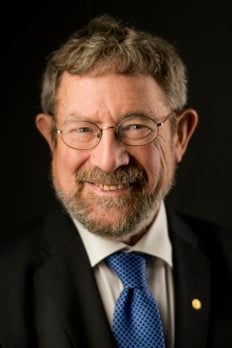 Childhood
Childhood
I was born on June 22, 1943 in wartime Aberdeen, Scotland and lived there for the first sixteen years of my life. My parents, Hans Walter and Johanna Maria Kosterlitz (Gresshöner) had fled Hitler’s Germany in 1934 because my father, a non-practicing Jew, came from a Jewish family and was forbidden to marry a non-Jewish woman like my mother or to be paid as a medical doctor in Berlin. Under the circumstances, my father decided that it would be in his best interests to leave Germany and accept the offer of a lectureship at Aberdeen University. My mother, who came from a conventional Christian German family, decided that she would follow my father to Britain so that they could be married, which they were in Glasgow.
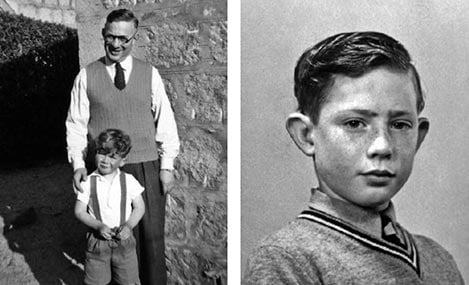
I had a happy childhood in Cults which used to be a small village just outside Aberdeen and separated by farms and fields from the city but now is just another suburb of a much larger city. I was raised as a British child unaware of my German origins, although I was aware that my parents were different from those of my friends because they had a secret language used to communicate when they wanted to exclude me. My parents would have nothing to do with Germany and spoke only English at home except occasionally under special circumstances. As a result, I grew up speaking only English and had to wait several years before learning some basic German at school. In fact, for several years I did not know I was actually of German Jewish origin nor did I know what being Jewish meant. The only thing I knew was that a boy in my class got some extra vacation because of his Jewish religion. When this became known among the class, everyone wanted to change their religion for the extra holidays. My father had no interest in religion and left all instruction in these matters to my mother, who was a devout Christian. I was a nominal church going Christian until I left home for Cambridge University on a scholarship when, to my great relief, I could drop all religion and become my natural atheist self.
Education
My early schooling was in Aberdeen at a semi private school, Robert Gordon’s College, which I attended from kindergarten up to age sixteen. There I had a broad education including the sciences, mathematics, history, geography, Latin and French with a strong Aberdonian accent. Some of the teaching left much to be desired particularly in physics where even I, at the age of fourteen, could tell that the teacher did not understand the subject. My parents decided that I showed some talent for academics and that I was worth grooming for Cambridge or Oxford University. In 1959, I went to Edinburgh Academy where the English A and S level subjects were taught. There I was able to specialize in the sciences and mathematics. With the improved teaching, I found I could do best in physics and mathematics. Eventually, I concluded that the reason for this was that my ability to make logical deductions compensated for my unreliable memory.
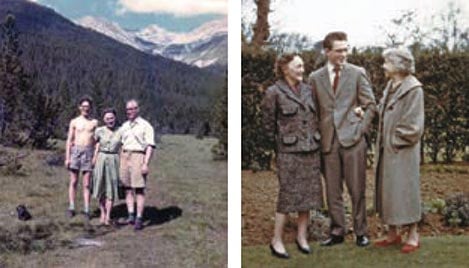
At school, I was fairly average at the humanities but excelled at mathematics and the sciences. Chemistry was the science I enjoyed most because we were allowed a lot of freedom in the laboratory at school, where I would carry out various forbidden syntheses of explosives and other noxious substances. I remember a few occasions where the lab had to be evacuated when one of these experiments went wrong and a noxious gas escaped. Despite the enjoyment these chemistry “experiments” gave me, I was not very good at the subject because of the memory required and I had to make too many guesses, especially when we studied organic chemistry where the chemical formulae were too complicated to memorize. However, despite the rather boring experimental part, physics was where I excelled at school. It satisfied my six fact memory limit because I was able to deduce correct results more often than not. Also, about this time in my life, I discovered that I am red green blind and that this disability does not fit well with chemistry. Some of the experiments required me to distinguish between several test tubes each containing a different reddish fluid. They all looked the same to me, but my classmates assured me that they were all quite different. At this point, I decided that chemistry was not for me despite all the fun I had mixing the various chemicals I could access.
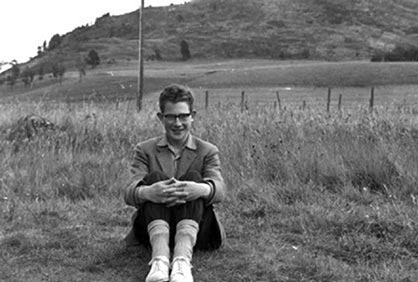
While I was at Edinburgh Academy, along with several fellow students, I sat the Cambridge University scholarship examination and, to my great pleasure, I was awarded a major scholarship in the Natural Sciences to Gonville and Caius College. A condition for attending Edinburgh Academy was that one joined the army cadet corps. Once every week in Edinburgh, I wore my kilt feeling foolish. Despite being born and raised in Aberdeen, Scotland, I did not have a drop of Scottish blood in me and had never worn the kilt before. I came to understand Edinburgh’s reputation as a windy city by parading through the streets in winter in my kilt in the usual cold horizontal rain which is an experience never to be forgotten.
Undergraduate Years
As an undergraduate at Cambridge from 1961 to 1965, I did the natural sciences tripos which covered most of the science subjects of that time. I chose to do physics, mathematics, chemistry and biochemistry because I enjoyed the chemistry at school. My color blindness again made this very frustrating and my poor memory made organic chemistry a bit of a nightmare as there were many situations where guessing did not work. I remember one situation in a biochemical experiment, where I ended up with a test tube containing some nondescript fluid. I was staring at it wondering what I should see in it or if I should do something else to the contents when, suddenly, it started to change color. Instinctively, I averted my gaze just before the test tube exploded. To this day, I have no idea what happened but that episode confirmed that chemistry was not for me and that the less dangerous and less memory intensive subject of physics would be my best bet. For fun, I joined the Cambridge Climbing Club which ran a bus or minibus to Derbyshire or North Wales every weekend. I discovered I was good at rock climbing and enjoyed the thrill of being high on a cliff with almost nothing to stop a fatal fall. From that moment, climbing at weekends became like a drug and I became obsessed by the sport.
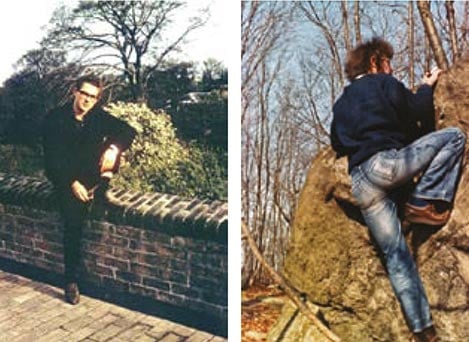
About this time my grandmother died at age ninety-two and left me a small bequest which I promptly spent on a car and the necessary insurance. With the help of my little car a typical weekend would be scheduled as: Friday evening – drive as fast as possible to Llanberis pass in North Wales or to the Lake District or, in the cold winter, to Glencoe or Ben Nevis in Scotland for the ice climbing. Climb on Saturday and Sunday, if not raining, and drive back to Cambridge late Sunday night and early Monday morning. Then I would sleep until I woke too late to go to class, thus not having any lecture notes. The weekly tutorials kept my nose to the grindstone and rescued my academic career.
My life settled into a routine which was close to my father’s dictum of work hard and play hard. By now Berit had become part of my weekly routine. Although she did not climb herself, she enjoyed being with me in the mountains. On Friday evening, Berit and I would jump into the car and drive as fast as possible to North Wales and Berit blames this period in our lives for causing whiplash injuries to her neck. We would return to Cambridge or Oxford late on Sunday after a hair raising race through the dark and I would try to stay awake in class until the following Friday. I would often leave for an afternoon’s climbing on some closer rocks once a week or perhaps do a bit of climbing on some nearby buildings. I had so much fun with these extra curricular activities that I seriously neglected my studies, especially in my final year. Also, in the Part 1 exams at the end of my second year at Cambridge, I did rather well in line with the expectations of me as major scholarship holder and I now expected to obtain a first-class degree in my third year with ease.
However, I did not perform as expected in the all-important final year and ended with an upper second class degree. I am a bit surprised that I did so well because I hardly studied, nor did I attend many classes mostly because I had done so well in the first two years without studying much. I thought to myself “Michael, you are some sort of genius”, but the final year taught me differently. Shortly before the final exam, I realized that I did not know what had been in the syllabus and panicked. I borrowed lecture notes from friends as I did not have any and read and read for most of each day as I watched time passing inexorably towards the final examinations. I struggled with questions I half understood, knowing that my enjoyable undergraduate days of climbing and pubs were now exacting their price. In the summer, I went on a climbing expedition to the Peruvian Andes where I could forget my Cambridge failures.
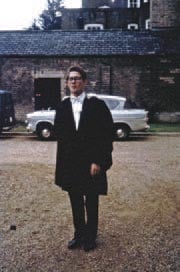
While I was in Peru, my father arranged for me to have an extra year, 1965– 66, at Cambridge to do Part III mathematics to try to improve my disappointing performance. He was an eminent academic who well understood the importance of a Ph.D. degree. This year was a mixed success because I did not appreciate the almost rigorous approach of the applied mathematicians and physicists teaching the courses. Much of what I learned I found useful later. Unfortunately, I had not learned my lesson and my obsession with rock climbing again prevented me from spending the necessary time and effort my studies really needed. Again, I had to be satisfied with an upper second class performance. At the end of the year, I was lucky to have the necessary qualification for graduate school at Cambridge, but not in high energy theory which I was determined to do. I was offered a position with Nevill Mott in experimental solid state physics but I turned this down in favor of an offer from Oxford in high energy theory.
Graduate and postdoctoral years
I spent the next three years, 1966–69, in Oxford sharing a rented house with several medical students and my future wife, who spent the time complaining that she had to work too hard keeping several messy males tidy, clean and fed while I worked on my Oxford D.Phil. We quickly fell into a routine where Berit left for work at 8:00 am and I at 10:30 am to arrive for the 11:00 am coffee at Rudolph Peierls’ department of theoretical physics. My D.Phil. supervisor, John Taylor, left me alone to do my own research and find my own problems which upset me at the time but, in retrospect, this was excellent training for my later career. Whatever his reasons, I am eternally grateful to John for putting up with my foibles at Oxford. I managed to write three papers on Regge poles and the Veneziano model, a precursor to modern string theory, with other graduate students.
These were the subjects I would continue to work on in Torino and later at Birmingham until I changed fields. In 1969, I managed to write my thesis, imaginatively titled “Problems in strong interaction physics”, which, I suspect, has never been read. Of course, the weekends and vacations were still reserved for my climbing obsession, which still occupied all my leisure time. At this time, I spent all summer vacations climbing in the French or Italian Alps and even Yosemite Valley in the USA and managed to get quite a reputation as a mountaineer.
Our next adventure was when I managed to obtain a Royal Society grant for a postdoctoral fellowship which I could use anywhere in Europe. I decided on the Istituto di Fisica Teorica, Torino, Italy because Sergio Fubini, one of the pioneers of modern string theory, was there but, more importantly, it was close to the Alps where the best mountains such as Mont Blanc are situated. Neither Berit nor I spoke any Italian but we were young enough that this was just a minor challenge to be overcome. We had many other interesting challenges to overcome of which renting an apartment and furnishing it, all in Italian, was one. Another was to deal with the local car drivers. I learned to love alpine skiing, made contact with outstanding local climbers and created a climb in the Val d’Orco which bears my name, “Fessura Kosterlitz” which was not repeated for a decade. My achievements in physics are somewhat less well known but I did do some very long calculations on a precursor to modern string theory. This resulted in one paper “The General N-Point Vertex in a Dual Model” with a fellow postdoc, Dennis Wray. I did not realize at the time that I was in the forefront doing research in what was later to become string theory.
While I was in Italy, there occurred a pivotal event which led to my Nobel Prize. I applied to CERN for a postdoctoral position for 1971–1972 but failed to submit the necessary paperwork in a timely fashion and was turned down. Panic set in as the prospect of unemployment hung over me. Berit walked to the main train station to buy a British newspaper which contained advertisements for academic jobs. There was one for a three-year postdoctoral position at Birmingham University in England and I dutifully applied for this although I did not really want to go there for high energy physics. I got offered the job and duly accepted.
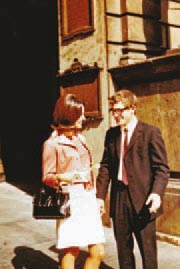
Another, even more pivotal, event occurred in Italy. Berit and I had by now been an inseparable couple for seven years. The question of marriage arose on and off during those years, but we decided that I was too immature and the three-year difference between our ages was too great. By now we felt differently and I suggested that our relationship seemed very stable and we might as well make it legal. We married in Torino in September 1970 after a long battle with the local bureaucracy. Also, this avoided the problem of obtaining work permits for Berit. Since then, we have had more than a few adventures and three children who are now settled in Boston and Providence in New England. We have also been blessed with five grandchildren.
I spent the next three years, 1970–1973, as a Research Fellow at the Department of Mathematical Physics at Birmingham University. I continued my calculations on the dual resonance model of Veneziano and was about to write up my calculations when a preprint by a group at Berkeley doing exactly what I had done appeared on my desk. Needless to say, I was rather annoyed but shrugged my shoulders and started a new long and laborious calculation. I completed this and started to write it up when another Berkeley preprint arrived on my desk. When this happened yet a third time, I did get rather upset and went from office to office asking the occupants if they had a problem I could look at or if I could help in some way. Eventually, I found myself in David Thouless’ office listening as he described concepts and ideas I knew nothing about. He talked about superfluidity in 4He films, crystals in two dimensions, vortices, dislocations, topology and many other related ideas.
Although this was all new to me, as was statistical mechanics which I had ignored as being unnecessary for high energy physics, the ideas made sense to me. After I left David’s office with my head spinning with all these new ideas and concepts, I returned to my own smaller office and began to work on these new wonderful ideas which David had introduced to me. The central idea was that the only way a flow in 4He can dissipate is by the creation of vortices and their subsequent motion. A superfluid can be characterized by the absence of free vortices and a normal, dissipating fluid by the presence of a finite concentration in thermal equilibrium. In two dimensions, the problem becomes equivalent to the equilibrium statistical mechanics of a set of point charges interacting by a Coulomb potential. David and I introduced the concept of a vortex as a topological excitation or defect. The same ideas can be used to discuss the melting of a two-dimensional crystal with point dislocations playing the same role as vortices in a superfluid. David and I wrote two papers on this [1, 2] where we discussed the basic theory of defect mediated transitions. About this time, David casually directed my attention to some papers by Phil Anderson and coworkers on the Kondo problem and its mapping to a one dimensional 1/r2 Ising model [3] which introduced me to renormalization group methods, although this terminology only came into use later. I did nothing for six months but reading and re-reading this seminal paper and reproducing the calculations to try to understand it. During this time, Berit tried in vain to tidy my office but was firmly told to leave all papers alone. A year later, based on this research, I published a paper which discusses a renormalization group treatment of the two-dimensional planar rotor model of superfluid 4He [4] which is the basis for the exact prediction for the superfluid density [5].
My next position arranged by David Thouless was as a Postdoctoral Fellow at LASSP at Cornell in 1973–74. There I met Michael Fisher and his young, very smart graduate student, David Nelson. Even at this early stage in his career, David demonstrated that he was going to become something special. I was excited by the prospect of learning about phase transitions and critical phenomena from the Cornell experts, Michael Fisher and Ken Wilson. Field theoretic methods and the epsilon expansion of Wilson and Fisher [6] had permitted enormous progress in understanding a huge variety of phase transitions and I badly wanted to be one of the pioneers in this. Working with Nelson and Fisher opened my eyes to what physics is all about, how important experimental data are and how to choose the problems to work on. In the 1970s, critical phenomena was a field which was at last opening out by Wilson and Fisher’s epsilon expansion methods. With Nelson and Fisher, I worked on bicritical points using renormalization group methods. To our great pleasure, we were able to understand in great detail the shape of the phase diagram in the vicinity of a bicritical point and why the various phase boundaries had the shape of experiments on anisotropic antiferromagnets. This was at the height of the development of critical phenomena in 4 − Ɛ dimensions and I was excited to be in the middle of it with the leading authorities in the field. I learned the importance of testing one’s theory against the ultimate authority in physics, experiment.
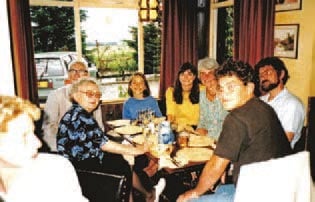
During all my postdoctoral years I kept to my mantra: first climbing, then physics and last family. In fact, when I was in my twenties, I was one of the best climbers in Britain and even considered giving up physics in favor of a professional climbing career. My teaching duties prevented me from going on any of the Himalayan expeditions I could have joined. However, on thinking about the possible consequences of this choice, sanity and my wife finally prevailed. I realized that, although I was technically good enough, a career in academia and physics would allow me enough vacation time to indulge in my climbing obsession. Some of my climbing acquaintances had chosen to become professional mountaineers and a few succeeded but most did not. I decided that I would probably not succeed in this.
Tenured years: Birmingham and Brown
I returned to Birmingham University in 1974 as a tenured lecturer, then was promoted to Senior Lecturer in 1978 and finally to Reader in 1980. I continued working on phase transitions and critical phenomena while teaching two courses at the same time. David Nelson and I managed to produce our important prediction for the superfluid density of a thin film of 4He [5], but my significant output slowed down although I produced several papers on critical phenomena. David Thouless was still at Birmingham, during which time we continued our collaboration on spin glasses until he moved to the USA. I spent a semester in 1978 as a visiting professor at Princeton, Bell Laboratories and Harvard respectively, bringing my family. My stay at Harvard was especially productive as David Nelson and I wrote our paper “Universal Jump in the Superfluid Density of Two-Dimensional Superfluids.”
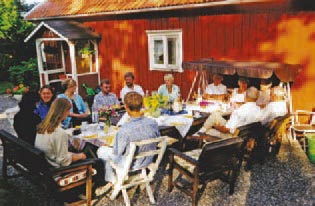
By 1978 we had two children in Birmingham schools and my wife and I were happy and thought we were settled there forever. I was doing what I loved, climbing, immersed in physics, and spending the remaining time with my growing family. However, this contented period of my life was not to last, because I contracted the nasty autoimmune disease of multiple sclerosis. I awoke one day in September 1978 and was unable to stand up because my balance did not function. I was admitted to hospital where I spent one week while the doctors tried to figure out what was wrong. Eventually, a solemn neurologist said that there were two possibilities, a brain tumor or multiple sclerosis, of which the latter was the better alternative. It turned out I did indeed suffer from MS and life as I knew it was forever changed. Needless to say, I did not react well to this news as I assumed it meant the mountaineering half of my life was over and I would have to live the rest of my life without it. My wife was not as upset as I was because, by this time, a number of my climbing friends had died in climbing accidents and she was relieved that this would not happen to her husband. However, this thought was little consolation to me who could not envisage life without the mountains and I went into a deep depression which lasted for several years. The professor of neurology offered these kind words of encouragement, “There is no cure, some people live longer than others. If you can look back after 25 years you will know how bad a case you are.” Needless to say, this information also affected my physics productivity for a few years.
In 1979 I was offered a position as a tenured full professor at Brown University and Birmingham counter offered a promotion to a research professor as an incentive to stay. This would be at a Center of Excellence centered at Birmingham, which I was inclined to accept. I was about to refuse the offer from Brown when Birmingham abruptly withdrew their offer. Combined with my illness, for which I subconsciously blamed Britain, this was the last straw and I immediately tendered my resignation and left for Brown, where we have been since 1982. My wife and I finally became citizens of the USA in 2004 because, in that year, Sweden permitted dual nationality and my wife did not wish to give up her Swedish nationality. As a British citizen, I had no difficulty because Britain has always permitted dual nationality. After 9/11, I felt that my wife and I and, especially, our children needed the protection of citizenship, so we paid a lot of money to an immigration lawyer and became US citizens in 2004.
At Brown, my interests changed somewhat and, with the help of a grant from NSF, I started to work on various effects in two dimensional arrays of Josephson junctions such as disorder and in a magnetic field. These can be represented by a frustrated planar rotor model, which is quite different from the original 2D planar rotor model [4]. In this, I was greatly helped by a very good graduate student from Brazil, Enzo Granato. This system is an excellent system for the study of many variants of the original system of Kosterlitz and Thouless and is still under quite active theoretical and experimental investigation. We looked at some of the more elementary aspects of the system and slightly increased our understanding of it. These experimentally accessible variants of the model took us out of the realm of analytic work and my student and I turned to numerical simulations, which was the only way we could make any progress. This has turned into a more than twenty-year collaboration with Enzo at INPE in Brazil.
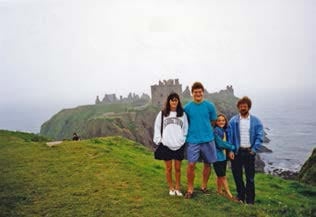
In 1985, I went on a sabbatical to France, bringing my family as I realized this might be the last opportunity for a family adventure. The children went to French schools and I spent six months at Saclay and Orsay with my Brown graduate students continuing the work on planar rotor models.
On return to Brown I became interested in numerical work with a couple of graduate students from Korea. Our projects were to study the kinetics of growth of a surface by random deposition. We studied the scaling of the interface width with time and evaluated the exponent to a high degree of accuracy. However, we could not compete with the massive simulations from a group in Germany. The other project was to investigate if it was possible to identify a weak first order transition by purely numerical methods [7] which method is still being used in 2016. Jooyoung has turned his talents to the protein folding problem and his group is now recognized as a leader in this field as they consistently score very highly in the CASP competitions. A Japanese graduate student, Nobuhiko Akino, has been very successful in his numerical work on randomness in superconductors and in XY spin glasses which have been longstanding intractable problems. We concluded that an XY spin glass exists in three dimensions and above, which result can also be obtained via massive simulations.
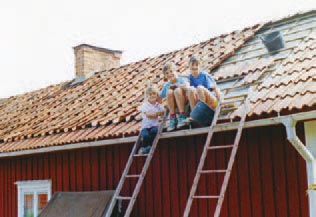
For reasons which are still unclear to me, I lost my NSF funding over this and have never been able to get it back. However, the problem never stopped to intrigue me and over the last ten years I have doggedly pursued the solution although it has proven to be somewhat elusive. I had a brilliant graduate student given to me by Brown who was invaluable help to me doing difficult numerical work, and together we managed to get a paper accepted in 2010.
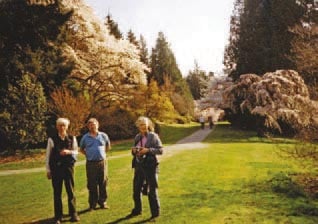
I also have had a longstanding collaboration for the last twenty-five years with my colleague Tapio Ala-Nissila in Finland working on phase field models of growth. This is a surprisingly successful method for the numerical study of growth in fluids and in solids which we recently applied to the hydrodynamics of crystals [8]. This collaboration has also included my colleague, Martin Grant, at McGill in Montreal, Canada and Ken Elder at Oakland University in Michigan, USA as well as my Brown colleague See-Chen Jing. I also started a collaboration at the Korea Institute of Advanced Study in Seoul, Korea where I am now a Distinguished Professor visiting for two months every summer. Even at my advanced age of 73, physics still fascinates me because there are so many problems waiting for a solution that, despite my increasing incompetence, I would like to see understood before I retire. Perhaps in this respect, I am like my father who refused to give up working until he was over 90! On reflection having produced nearly sixty papers in my time at Brown is not bad, but nothing will ever compare to the exhilaration of our 1977 paper [5] when theory agreed quantitatively with experiment [9]. Each summer, Berit and I travel a lot, spending time in Brazil, Finland and Korea but always keep four or more weeks sacrosanct for our Swedish summer house where we can relax completely by watching the grass grow. The only disadvantage is that it always does grow and then needs cutting, which gives me about the only exercise I have during the year.
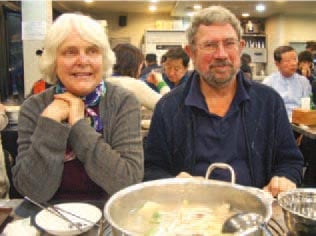
Last but by no means least, I am happy that I have managed to work since that dreadful day in September 1978 when I was diagnosed with MS. The twenty-five years have gone and, as predicted by the neurologist then, I now know the outcome. I was not a bad case. I had attacks every 18 months from age 35 to 55, some quite bad, some small relapses. When I was 55 my neurologist put me into a trial for a new MS drug. This was very successful and opened up a whole new field of pharmacological drugs for the easing of MS. Since then, I have been lucky in that I have never had another attack. I only battle the deadly fatigue that comes with the disease. I want to take this space to tell any budding scientist that, however bleak the future may seem due to illness or other problems, one cannot say you will not be successful.
More people than I can list here have contributed in vital ways to my success. Those that are probably the most important are David Thouless whose friendship, patience and collaboration are central to my career, Berit, my wife, for her patience and forbearance with my peculiarities and absences when I was either climbing mountains or working too hard and my children, Karin, Jonathan and Elisabeth for putting up with and loving their strange father who was absent too often and too long. I also acknowledge the support and friendship of my colleagues at Birmingham and Brown.
References
- J.M. Kosterlitz and D.J. Thouless, J Phys C: Solid State Phys 5 L124–6 (1972).
- J.M. Kosterlitz and D.J. Thouless, J Phys C: Solid State Phys 6 1181–203 (1973).
- P.W. Anderson, G. Yuval and D.R. Hammann, Phys Rev B 1 4464 (1970).
- J.M. Kosterlitz, J Phys C: Solid State Phys 7 1046–60 (1974).
- D.R. Nelson and J.M. Kosterlitz, Phys Rev Lett 39 1201 (1977).
- K.G. Wilson and M.E. Fisher, Phys Rev Lett 28 240–3 (1972).
- Jooyoung Lee and J.M. Kosterlitz, Phys Rev Lett 1990 137 (1990).
- V. Heinonen et al., Phys Rev Lett 116 024303 (2016).
- D.J. Bishop and J.D. Reppy, Phys Rev Lett 40 1727–30 (1978).
This autobiography/biography was written at the time of the award and later published in the book series Les Prix Nobel/ Nobel Lectures/The Nobel Prizes. The information is sometimes updated with an addendum submitted by the Laureate.
Nobel Prizes and laureates
Six prizes were awarded for achievements that have conferred the greatest benefit to humankind. The 14 laureates' work and discoveries range from quantum tunnelling to promoting democratic rights.
See them all presented here.
